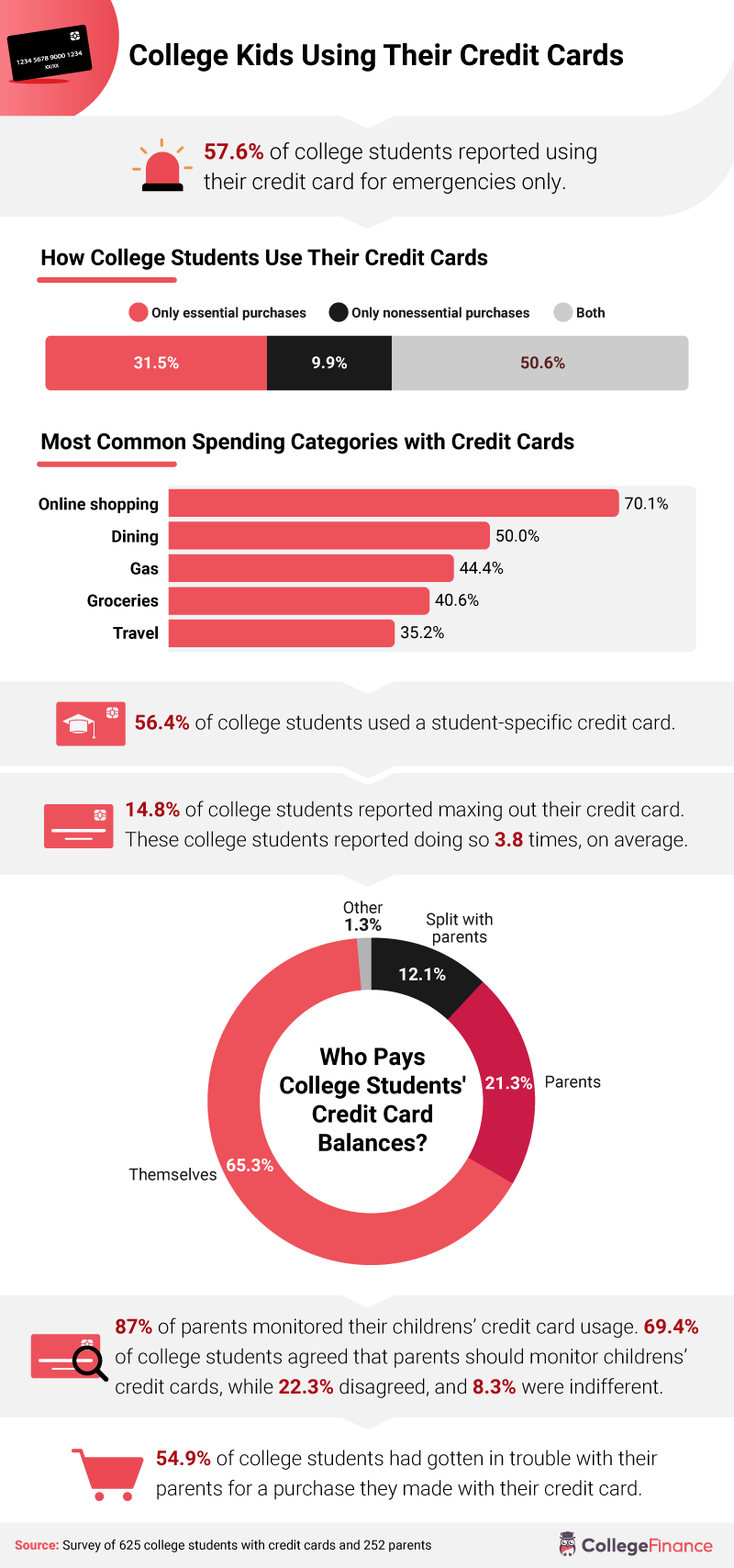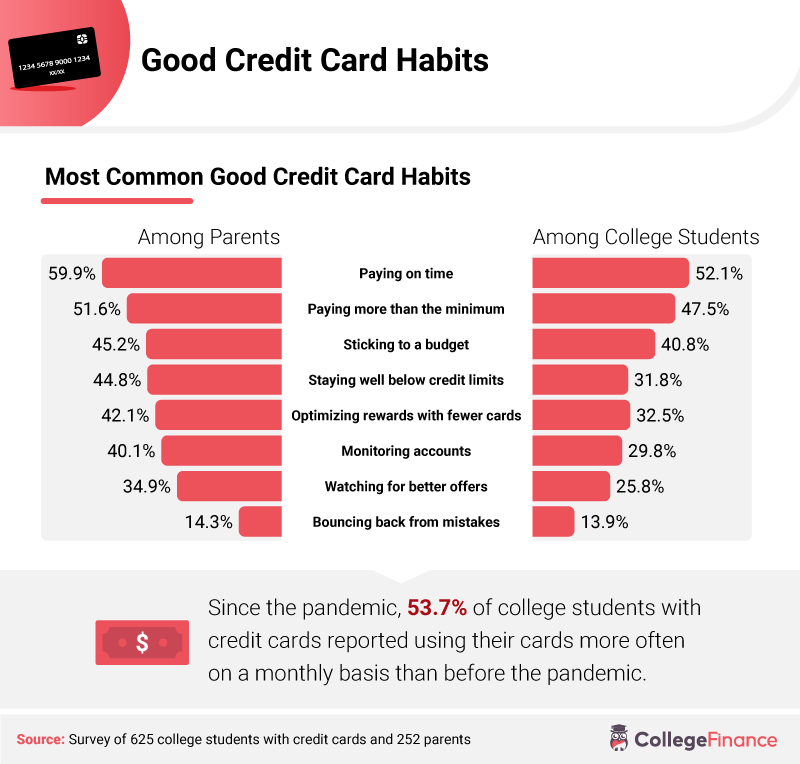College Student Debt and Credit Card Usage

Key Takeaways
- On average, college students have over $3,280 worth of credit card debt.
- 64.8% of college students have some form of credit card debt.
- The most common credit card mistakes college students make are only paying the minimum amount (44.7%) and missing a payment (37.6%).
- The top three spending categories for college students with their credit cards were online shopping (70.1%), dining (50%), and gas (44.4%).
Credit Card Spending
As the United States consumer debt figures reach new heights each following quarter, it’s no question that the average American is probably at least somewhat concerned with their financial health. Seeing as tuition costs for both private and public institutions have only increased since the mid-’80s, college students are quite obviously involved in this discussion. However, college students have more than just student loan payments to concern themselves with. Credit card debt for college students is an increasingly relevant phenomenon, especially when taking into account the adverse effects of the COVID-19 pandemic.
It is for this reason that we conducted a study that takes a closer look at the financial state of the average college student. We surveyed college students to effectively gauge how credit card debt stacks up to other forms of debt that college students experience; how and why college students obtain credit cards; how they are spending and paying off their credit; and the perceptions and realities of bad and good credit card habits. Read on to see what we found.
Debt Concerns
We’ve established that there are a number of reasons that college students experience financial pressure. With this in mind, let’s take a look at how credit card debt stacks up to other forms of debt.

In general, numbers showed that 96.3% of college students experience some form of debt. Clearly, respondents believed credit card debt is the most common form of college student debt. Unsurprisingly, student loan debt is close behind as the second-most common form of college student debt. As for which debt causes the most concern, credit card debt yet again came out on top, with 52.7% of respondents reporting it as the most worrying. Nearly 44% of respondents believed student loan debt naturally causes a significant amount of worry and stress, and understandably so. The Biden administration may not actively alleviate these concerns, as it’s unclear as to how or if the White House or Congress will implement student loan forgiveness policies.
When taking a closer look at just how much credit card debt the average college student accumulates, statistics show that this figure is over $3,280, even though their average credit card limit is $3,568.
When asked to select their preferred method of payment, of the respondents with credit cards, most (56.7%) responded that they pay with credit or debit, and a very small minority reported paying with cash or other forms of payment (33.8% debit card, 6.4% cash, etc.). Respondents without credit cards responded predictably as well, with 55.7% opting for debit card spending and 33% choosing cash.
Credit Card Craze
Upon noting the numerous forms of debt that afflict college students, it seems only natural to consider what circumstances would bring someone to pile onto the preexisting stressors associated with higher education. To take a deeper dive into this question, let’s first examine how the average college student gets their hands on credit cards in the first place.

When asked how they got their first credit card, an overwhelming majority of respondents either procured one themselves (50.6%) or through a parent (31.5%). As for why credit card usage is so popular among college students, there’s a number of reasons at play. According to college students, the most popular reasons they had for getting credit cards were simply wanting one for themselves (56.7%) and for building their credit (52.4%). Some more notable reasons were that they wanted to learn good credit habits (35%), their parents got it for them (32.8%), and for emergencies (23.7%).
With regards to credit card benefits, respondents believed that cashback was undoubtedly the most desirable reward, with 76.1% of college students valuing this perk. The next most preferred credit card reward was credit card points (51.6%). As for the most popular ways to receive credit card rewards, respondents favored online shopping (62.1%). Other popular methods to accumulate cash back or points were through gas (41.2%), dining (38.5%), grocery store (30.4%), and travel purchases (29.6%).
Shop ’Til You Drop
Understanding incentives is one thing. However, how are college kids actually spending? Let’s explore their credit card spending habits.

Roughly 57% of college students reported using their credit cards for emergencies only. This information is surprising, considering that the average college student, somehow, still racks up over $3,280 in credit card debt. Additionally, when asked whether respondents use their credit cards for essential purchases, nonessential purchases, or purchases from both categories, most responded with both (46.2%). Regarding where college students tend to shop with their credit cards, we observed that the world wide web was their most frequented place of commerce. More specifically, 70.1% of respondents reported their most common spending category to be online shopping. Other popular categories like dining (50%), gas (44.4%), groceries (40.6%), and travel purchases (35.2%) followed. Surprisingly, 10.5% of college students used their credit cards to buy alcohol, marijuana, and nicotine products
Fortunately, it appears that a small minority of students in our survey reported maxing out their credit cards. However, the 14.8% that did so managed to max out their card an average of 3.8 times. Still, a whopping 65.3% of respondents reported paying off their credit cards themselves, declaring some financial independence.
The Don’ts of Credit Cards
Credit card debt can often be attributed to bad saving and spending habits. Although, when taking into account the numerous responsibilities that fall on the shoulders of the modern-day college student, it becomes evident that maintaining financial well-being is often not a simple task.

Overall, one can say that parents and college students have similar opinions regarding which credit card habits are the worst. For instance, 44.4% of parents and 40.3% of college students believed that missing a payment is the worst of all credit card habits. This slight difference between the two groups persisted for most of the categories presented, such as habitually paying late (44% and 38.7%, respectively).
Aside from bad habit perceptions, actions speak more to the reality of which of these bad habits are actually practiced by both parents and students. Specifically, although more parent respondents believed that only making the minimum payment on their credit cards was a bigger deal than students did, the reality is that more parents have actually made this mistake. Specifically, 47.6% of parent respondents reported having only paid the minimum payment on their credit cards, while 44.7% of students did the same.
To-Dos With Credit Cards
While it’s certainly important to examine the root causes of credit card debt, it’s arguably equally important to do the same for the steps that students and parents alike are taking to stay on top of their credit card usage.

Considering that most college students (53.7%) reported spending more on their credit card debt on a monthly basis after the onset of the pandemic, maintaining good credit card habits has become increasingly important. With this in mind, let’s compare what good habits college students and parents have adopted.
According to both parents and college students, paying on time, paying more than the minimum, and sticking to a budget were the top three most commonly practiced good habits. The biggest discrepancy between parent and student respondents, however, was staying below credit limits (44.8% and 31.8%, respectively), suggesting college students should work to develop this habit. Additionally, it unsurprisingly appeared that parents generally practice more good habits, seeing as they had students beat in all categories.
Financial Independence
It is apparent the average American college student is faced with a significant degree of financial stressors. Accounting for these various forms of debt, best practices for minimizing it, and the preexisting responsibility of maintaining a GPA, it comes as no surprise that the average college student accumulates over $3,280 in debt. However, these students do show signs of succeeding with financial independence, as a majority manage their credit card bills on their own.
College prep can often seem daunting and overwhelming, especially when accounting for the financial well-being of the average college student. CollegeFinance.com directs you to the information and resources you need to make an informed and confident decision about your or your child’s future. Whether you need to plan for, borrow, repay, or compare student loans, CollegeFinance.com provides you the support you need to get the most out of your college investment.
Methodology and Limitations
For this study, we conducted three different surveys on Amazon MTurk. Firstly, we surveyed 625 college students who own a credit card. 40.1% identified as women, 59.6% identified as men, and 0.3% identified as nonbinary. The average age of these respondents was 31.5 years with a standard deviation of 9.7 years. Secondly, we surveyed 252 parents. 46% identified as women, 53.6% identified as men, and 0.4% identified as nonbinary. The average age of these respondents was 40.2 years with a standard deviation of 11.3 years. Lastly, we surveyed 115 college students without credit cards. 33% identified as women, and 67% identified as men. The average age of these respondents was 33.7 with a standard deviation of 11.3.
The main limitation of this portion of the study is the reliance on self-report, which is faced with several issues such as, but not limited to, attribution, exaggeration, recency bias, and telescoping.
Fair Use Statement
Though the U.S. consumer debt crisis continues to grow, there are always steps you can take to secure a better future for American students and families. Evidently, there’s certainly more to add to this discussion. If you find our data useful, feel free to spread the knowledge. Just make sure you do so for non-commercial use and provide a link back to our site.

